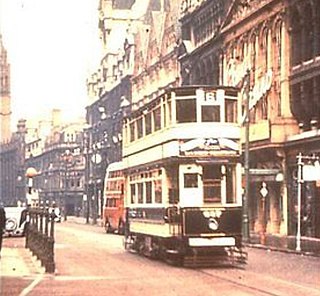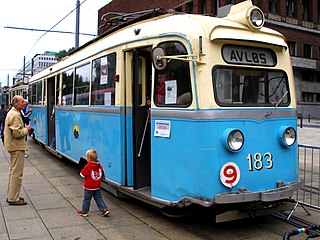
Hockley is a central inner-city district in the city of Birmingham, England. It lies about one mile north-west of the city centre, and is served by the Jewellery Quarter station. Birmingham's Jewellery Quarter continues to thrive in Hockley, and much of the original architecture and small artisan workshops have survived intact.

Midland Red was a bus company that operated in The Midlands from 1905 until 1981. It was one of the largest English bus companies, operating over a large area between Gloucester in the south and Derbyshire in the north, and from Northampton to the Welsh border. The company also manufactured buses.

The Sydney tramway network served the inner suburbs of Sydney, Australia from 1879 until 1961. In its heyday, it was the largest in Australia, the second largest in the Commonwealth of Nations, and one of the largest in the world. The network was heavily worked, with about 1,600 cars in service at any one time at its peak during the 1930s . Patronage peaked in 1945 at 405 million passenger journeys. Its maximum street trackage totalled 291 km in 1923.

Nottingham Corporation Tramways was formed when Nottingham Corporation took over the Nottingham and District Tramways Company Limited, which had operated a horse and steam tram service from 1877.

Sheffield Tramway was an extensive tramway network serving the English city of Sheffield and its suburbs.

Birmingham Corporation Tramways operated a network of tramways in Birmingham from 1904 until 1953. It was the largest narrow-gauge tramway network in the UK, and was built to a gauge of 3 ft 6 in. It was the fourth largest tramway network in the UK behind London, Glasgow and Manchester.
The City of Birmingham Tramways Company Ltd operated trams in Birmingham, England, from 1896 until 1911.

The Brisbane tramway network served the city of Brisbane, Australia, between 1885 and 1969. It ran on standard gauge track. The electric system was originally energised to 500 volts, and subsequently increased to 600 volts. All tramcars built in Brisbane up to 1938 had an open design. This proved so popular, especially on hot summer nights, that the trams were used as fundraisers and often chartered right up until the last service by social groups.

The Trieste–Opicina tramway is an unusual hybrid tramway and funicular railway in the city of Trieste, Italy. It links Piazza Oberdan, on the northern edge of the city centre, with the village of Villa Opicina in the hills above.

A tram accident is any accident involving a tram. Alternatively, any accident involving a tram or a tram system may be considered a tram accident. The latter definition is more commonly used in public safety studies.
Dover Corporation Tramways was the operator of the second tramway system built in the United Kingdom. It was in operation from 1897 to 1936. The worst ever tram accident in the United Kingdom occurred on the system in 1917.

Class B and Class E, normally referred to as Gullfisk, were a class of 46 trams built by Strømmens Værksted and Skabo Jernbanevognfabrikk for Oslo Sporveier and Bærumsbanen of Oslo, Norway, in 1937 and 1939. They were the first aluminium trams to operate on the Oslo Tramway and the first bogie trams to operate on street lines. They had contemporary modern electronic equipment, a streamlined shape, and comfortable accommodation. Till 1964, they were also faster than any other Norwegian tramcar or suburban railcar.

The Australian city of Hobart, Tasmania's capital city, no longer has a network of trams operating, but it once had an extensive and popular system that reached the majority of Hobart suburbs. The Hobart tram network was established in 1893 by a private consortium known as the Hobart Electric Tram Company, providing Hobart with the first complete electric tramway in the Southern Hemisphere. Its fleet of double-decker trams were the only such trams in Australia.

Coventry Corporation Tramways operated a tramway service in Coventry, England, between 1912 and 1940.

Tramways in Exeter were operated between 1882 and 1931. The first horse-drawn trams were operated by the Exeter Tramway Company but in 1904 the Exeter Corporation took over. They closed the old network and replaced it with a new one powered by electricity.
Rawtenstall Corporation Tramways operated a passenger tramway service in Rawtenstall between 1908 and 1932.
Halifax Corporation Tramways operated a tramway service in Halifax, West Yorkshire, England between 1898 and 1939. After considering lifts and inclined planes to assist trams in negotiating the steep hills to the south of the town, they obtained permission to build a conventional system in 1897, and the first three routes opened in 1898. By 1905 there were 37 miles (60 km) of track and 96 tramcars, supplied by two manufacturers. In 1921, an additional route was added to the system, and the Corporation embarked on a programme of building their own tramcars, some of which replaced existing vehicles, while some extended the fleet. During the 1930s, the trams were gradually replaced by motor buses, either run by the Corporation or by private companies, and the last tram ran on 14 February 1939.

The 1996 Dniprodzerzhynsk tram accident occurred on 2 July 1996, in Dniprodzerzhynsk, Dnipropetrovsk Oblast, Ukraine, when an overcrowded tram derailed during the evening rush hour, and crashed into a concrete wall. An investigation by the local railway department discovered that the brakes on the tram car failed as it was going down a hill. The derailment and subsequent crash killed a total of 34 people, and left over 100 others injured. The incident was the deadliest tram accident in the Ukraine, and one of the deadliest tram disasters anywhere in the world, surpassing the 1954 Zagreb tram accident which killed 19 people.

Rockhampton Council Tramways was a steam tram service which was operated by Rockhampton City Council from 1909 until 1939 in the city of Rockhampton, Queensland, Australia. Rockhampton was the only regional city in the state of Queensland to have had a tram service. The line has since been rebuilt and is operated as a tourist attraction by the Archer Park Rail Museum.

















